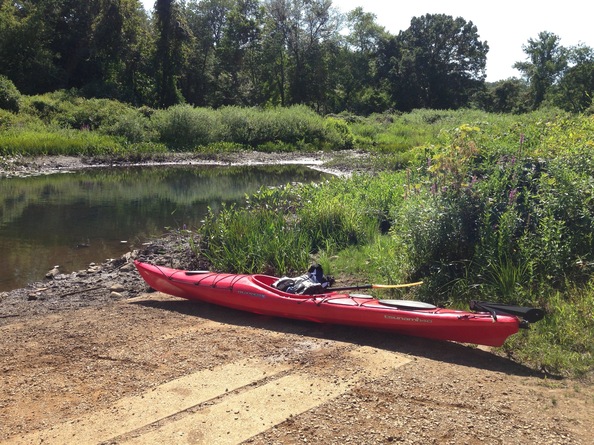I have a Wilderness Systems Tsunami 140 kayak. The Tsunami 140 is a 14’ long and 24” wide plastic (polyethylene) light touring kayak. Mine is a 2008 model, though I think the only difference between current models and mine is the seat — the new one is a clear improvement. Overall, I’m happy with the kayak. I’ve tracked mileage intermittently but I’d estimate I’ve put about 500 miles on it.
Some other details: the Tsunami is rated for a maximum load of 300 pounds. I’m 5’ 10” and about 240 pounds, and typically do not take much extra gear with me. So, I’m not topping out the weight limit on the kayak but I’m on the heavy side of what it’s rated for, and someone lighter than me would surely see the kayak handle differently. This is the only non-recreational kayak I’ve used for more than just a few minutes.
Getting into the Tsunami is always my biggest challenge. The cockpit is typical for a touring kayak, which is to say it’s much smaller than a typical recreational kayak. The Tsunami’s seat back is high compared to many others, however. The normal way to get into a small-cockpit kayak is to sit on the rear coaming and slide forward into the seat, however the high seat back gets in the way. While sliding in, the seat folds forward and gets in the way. To get into the Tsunami I need to slide one leg in, sit in the seat, then work to pull my other leg in. It’s not a well-balanced or elegant process. If I were more flexible and thinner I’m sure it’d be easier for me to get in. The seat is comfortable, though I’m not attached to the high seatback. I typically sit up straight to paddle, and to get good rotation out of my torso I don’t lean back. When resting it’s nice to lean back, though I don’t think I’d miss the seat back and would prefer a small backband just to make getting in and out easier.
Once in, the Tsunami is pretty stable: whether sitting still (“primary stability”) or moving (“secondary stability”) I feel comfortable that I’m not going to roll. (Of course, I try not to take wake from the side and turn into it to be as stable as possible.) I can wiggle around to adjust my position or contort myself to take a photo and I never fear rolling.
The one area I feel less stable is edging. The Tsunami is a multi-chine kayak, which is supposed to help bring good primary and secondary stability. (The “chine” is the shape of the hull as it rolls into the deck.) Leaning to edge causes a little bit of a sudden “flop” as the kayak shifts to another angle of the chine and that sudden movement makes me uncomfortable. (When I was trying to choose a kayak I liked the multi-chine design because of the additional stability it brings, however as I’ve become a better paddler I’ve outgrown the need for that comfort.) I don’t think the Tsunami can turn much better on edge, however, so working to roll the kayak and feel the “flop” is pointless.
The Tsunami tracks well and I never feel like I work too hard to turn it. I’m sure if I were used to a recreational kayak I’d say it turns slow, but it turns fast enough for me to consider it responsive, likely also due to the little bit of rocker the hull has. The 14’ length seems like a great compromise between speed and turning ability for the mostly-flatwater paddling I do.
I have a rudder on the Tsunami. It makes it much easier to get anywhere, and of course when fighting wind or current it helps keep the trip enjoyable. I typically paddle without the rudder because it’s a better way to hone my skills. Believe it or not, for photography I have found the rudder to be practically indispensable. The rudder makes it easy for me to keep my hands on the camera while still maneuvering the kayak to get a photo — whether it’s that I’ve paddled past the ideal spot and using the rudder to drift back into place, or using the rudder to help me hold my position while trying to take a photo.
The hatch covers are tight which is good, except that the day hatch is impossibly tight for me to get access to while in the kayak. There’s also not a bulkhead to separate the day hatch and rear compartment, so anything in there can slide out of reach of the day access anyway. There’s a bit of space behind the seat — enough to stuff a small drybag with anything I might need for the day. When I take two water bottles along I keep one under the deck rigging in front of the cockpit and put the second bottle behind the seat.
I think the Tsunami is a good light touring kayak for a beginner or intermediate paddler. After paddling the Tsunami for several years and working to improve my skill level, I feel like I’m reaching some of the limits of the kayak. I can easily define how I’ve grown past the kayak’s edging ability, though defining other ways I’m outgrowing it is more difficult. Regardless: recommended. With the exception of ease of climbing in and out it’s a significantly more capable kayak than any recreational kayak. The Tsunami is great for some relaxation on the water and for exercise. I’m glad I chose it!

Share Your Thoughts (